ACCY801 Report: Comparative Financial Analysis of BAPCOR and ADAIRS
VerifiedAdded on 2022/09/09
|16
|3764
|17
Report
AI Summary
This report presents a financial analysis of BAPCOR, a major automotive aftermarket parts supplier, and compares its performance to ADAIRS, a home furnishings retailer. The analysis, based on 2019 annual reports, evaluates liquidity, capital structure, asset management efficiency, profitability, and return on investment. BAPCOR demonstrates higher liquidity but lower profitability and asset management efficiency compared to ADAIRS. The report highlights BAPCOR's objectives, including network expansion and home-brand product growth, and ADAIRS's focus on distribution, product differentiation, and omni-retail capabilities. Recommendations include increasing efficiency in existing stores, focusing on advertisement and R&D. The report also examines capital expenditures by both companies, revealing BAPCOR's higher investment financed by a mix of debt and equity. Overall, the report suggests strategies for BAPCOR to improve its financial performance and competitiveness within the automotive aftermarket industry.
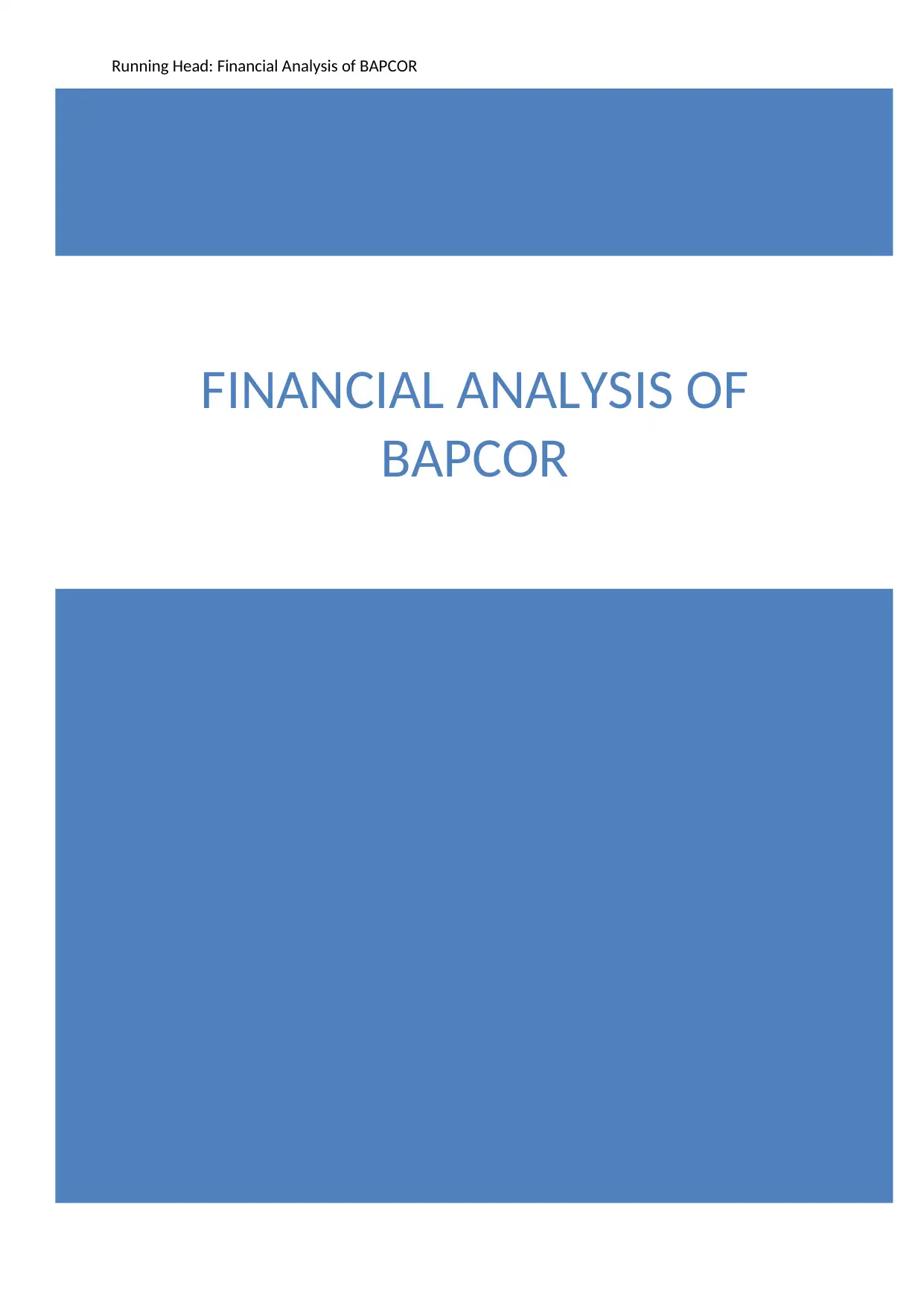
FINANCIAL ANALYSIS OF
BAPCOR
Running Head: Financial Analysis of BAPCOR
BAPCOR
Running Head: Financial Analysis of BAPCOR
Paraphrase This Document
Need a fresh take? Get an instant paraphrase of this document with our AI Paraphraser
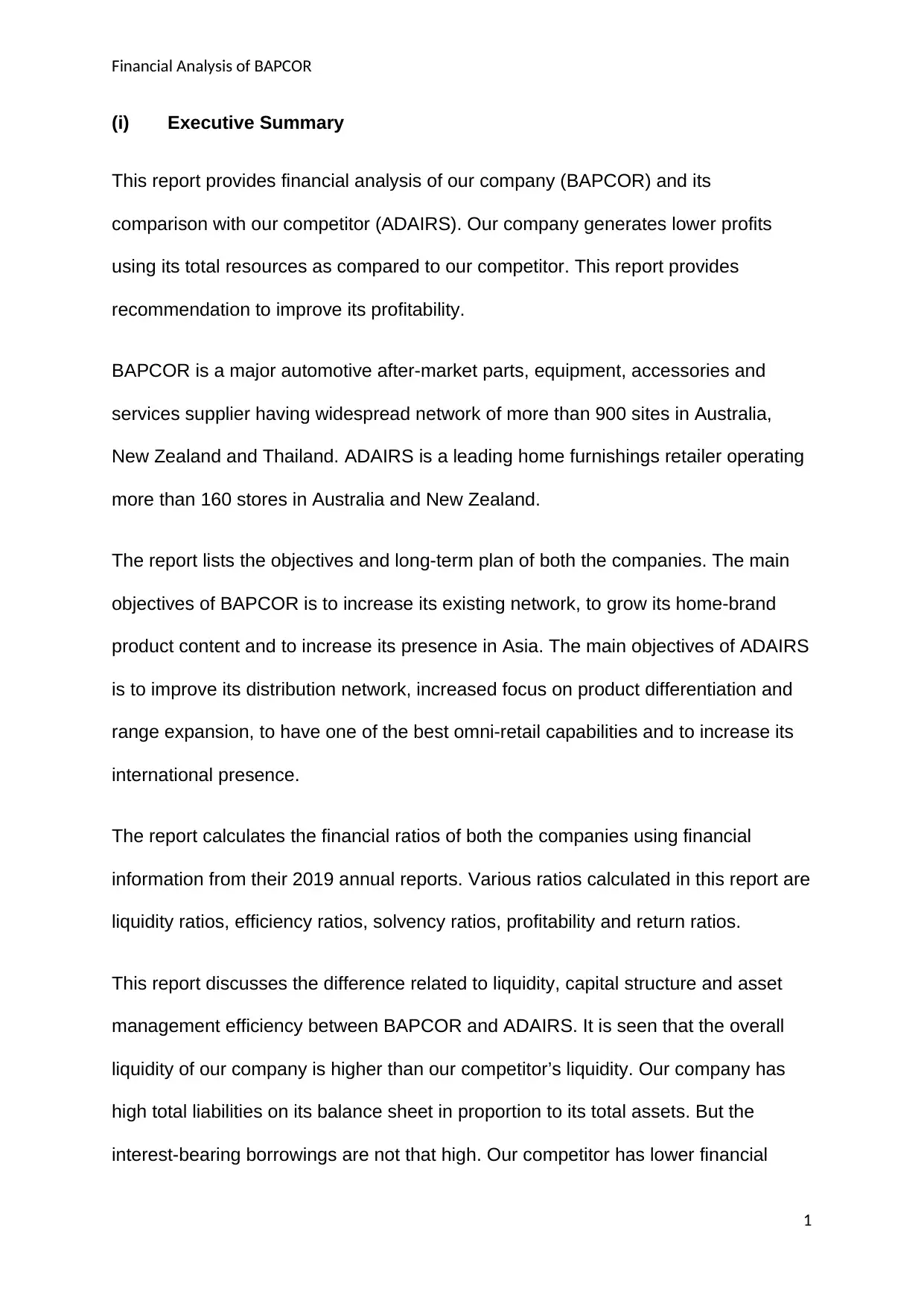
Financial Analysis of BAPCOR
(i) Executive Summary
This report provides financial analysis of our company (BAPCOR) and its
comparison with our competitor (ADAIRS). Our company generates lower profits
using its total resources as compared to our competitor. This report provides
recommendation to improve its profitability.
BAPCOR is a major automotive after-market parts, equipment, accessories and
services supplier having widespread network of more than 900 sites in Australia,
New Zealand and Thailand. ADAIRS is a leading home furnishings retailer operating
more than 160 stores in Australia and New Zealand.
The report lists the objectives and long-term plan of both the companies. The main
objectives of BAPCOR is to increase its existing network, to grow its home-brand
product content and to increase its presence in Asia. The main objectives of ADAIRS
is to improve its distribution network, increased focus on product differentiation and
range expansion, to have one of the best omni-retail capabilities and to increase its
international presence.
The report calculates the financial ratios of both the companies using financial
information from their 2019 annual reports. Various ratios calculated in this report are
liquidity ratios, efficiency ratios, solvency ratios, profitability and return ratios.
This report discusses the difference related to liquidity, capital structure and asset
management efficiency between BAPCOR and ADAIRS. It is seen that the overall
liquidity of our company is higher than our competitor’s liquidity. Our company has
high total liabilities on its balance sheet in proportion to its total assets. But the
interest-bearing borrowings are not that high. Our competitor has lower financial
1
(i) Executive Summary
This report provides financial analysis of our company (BAPCOR) and its
comparison with our competitor (ADAIRS). Our company generates lower profits
using its total resources as compared to our competitor. This report provides
recommendation to improve its profitability.
BAPCOR is a major automotive after-market parts, equipment, accessories and
services supplier having widespread network of more than 900 sites in Australia,
New Zealand and Thailand. ADAIRS is a leading home furnishings retailer operating
more than 160 stores in Australia and New Zealand.
The report lists the objectives and long-term plan of both the companies. The main
objectives of BAPCOR is to increase its existing network, to grow its home-brand
product content and to increase its presence in Asia. The main objectives of ADAIRS
is to improve its distribution network, increased focus on product differentiation and
range expansion, to have one of the best omni-retail capabilities and to increase its
international presence.
The report calculates the financial ratios of both the companies using financial
information from their 2019 annual reports. Various ratios calculated in this report are
liquidity ratios, efficiency ratios, solvency ratios, profitability and return ratios.
This report discusses the difference related to liquidity, capital structure and asset
management efficiency between BAPCOR and ADAIRS. It is seen that the overall
liquidity of our company is higher than our competitor’s liquidity. Our company has
high total liabilities on its balance sheet in proportion to its total assets. But the
interest-bearing borrowings are not that high. Our competitor has lower financial
1
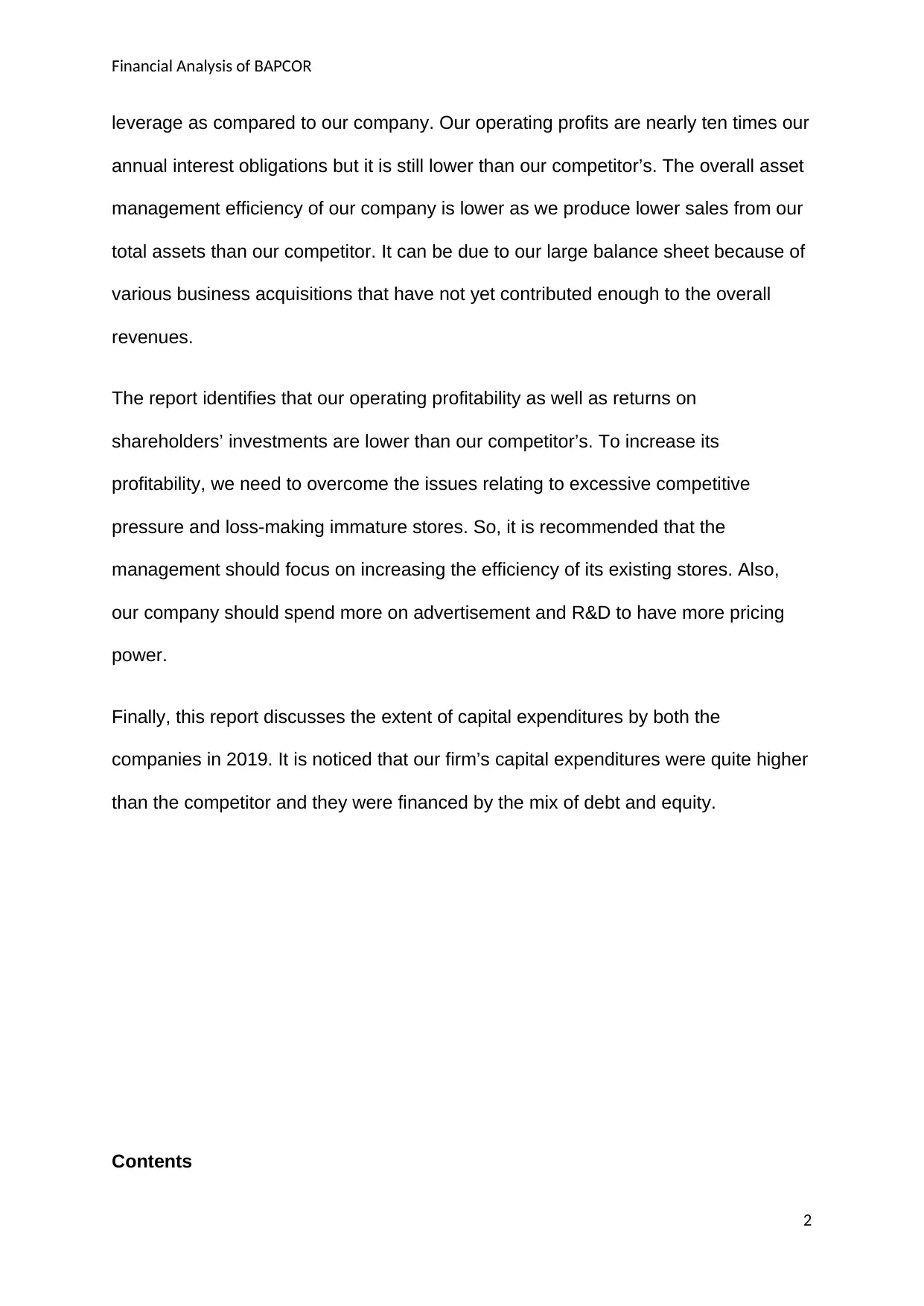
Financial Analysis of BAPCOR
leverage as compared to our company. Our operating profits are nearly ten times our
annual interest obligations but it is still lower than our competitor’s. The overall asset
management efficiency of our company is lower as we produce lower sales from our
total assets than our competitor. It can be due to our large balance sheet because of
various business acquisitions that have not yet contributed enough to the overall
revenues.
The report identifies that our operating profitability as well as returns on
shareholders’ investments are lower than our competitor’s. To increase its
profitability, we need to overcome the issues relating to excessive competitive
pressure and loss-making immature stores. So, it is recommended that the
management should focus on increasing the efficiency of its existing stores. Also,
our company should spend more on advertisement and R&D to have more pricing
power.
Finally, this report discusses the extent of capital expenditures by both the
companies in 2019. It is noticed that our firm’s capital expenditures were quite higher
than the competitor and they were financed by the mix of debt and equity.
Contents
2
leverage as compared to our company. Our operating profits are nearly ten times our
annual interest obligations but it is still lower than our competitor’s. The overall asset
management efficiency of our company is lower as we produce lower sales from our
total assets than our competitor. It can be due to our large balance sheet because of
various business acquisitions that have not yet contributed enough to the overall
revenues.
The report identifies that our operating profitability as well as returns on
shareholders’ investments are lower than our competitor’s. To increase its
profitability, we need to overcome the issues relating to excessive competitive
pressure and loss-making immature stores. So, it is recommended that the
management should focus on increasing the efficiency of its existing stores. Also,
our company should spend more on advertisement and R&D to have more pricing
power.
Finally, this report discusses the extent of capital expenditures by both the
companies in 2019. It is noticed that our firm’s capital expenditures were quite higher
than the competitor and they were financed by the mix of debt and equity.
Contents
2
⊘ This is a preview!⊘
Do you want full access?
Subscribe today to unlock all pages.

Trusted by 1+ million students worldwide
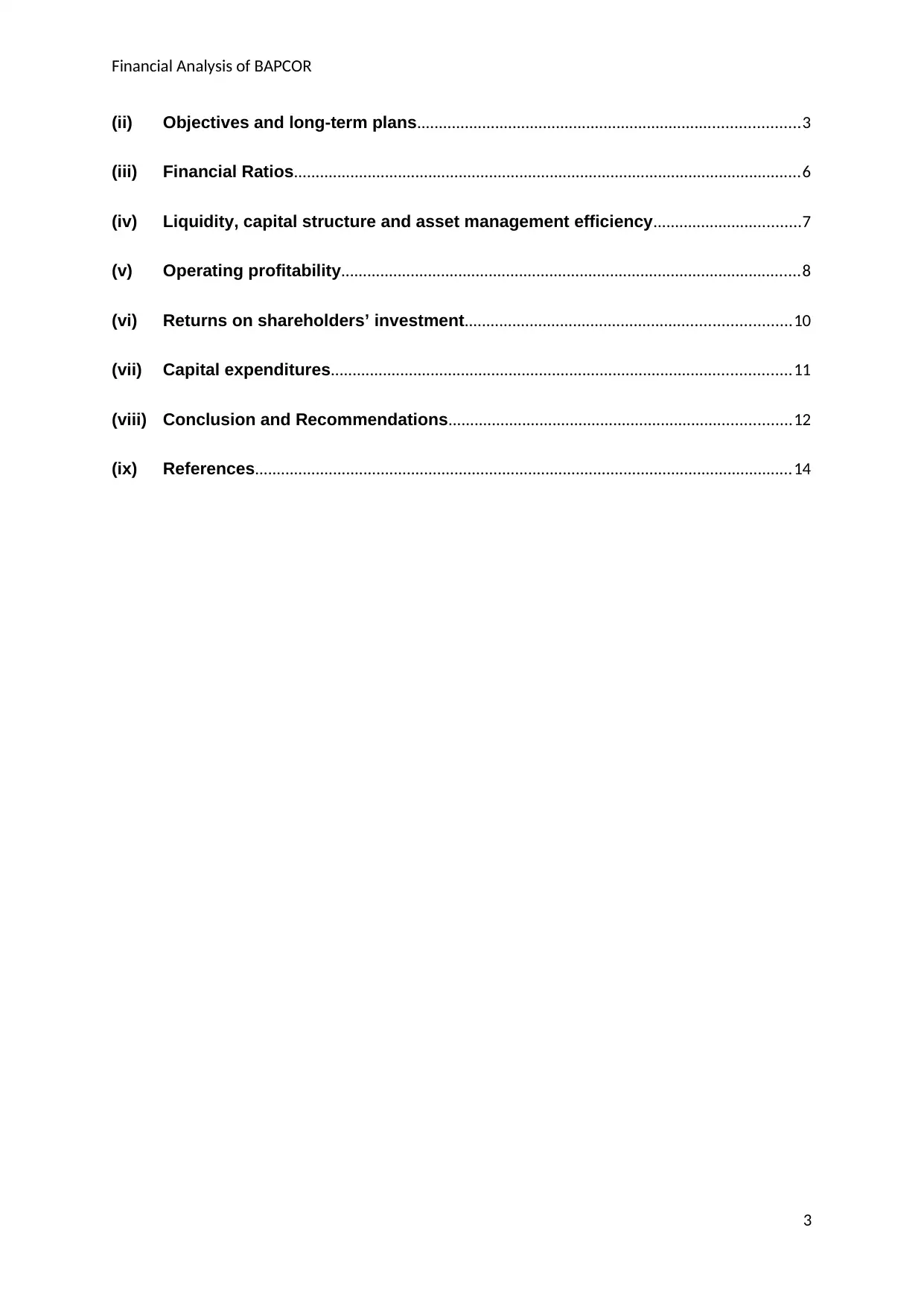
Financial Analysis of BAPCOR
(ii) Objectives and long-term plans........................................................................................3
(iii) Financial Ratios.....................................................................................................................6
(iv) Liquidity, capital structure and asset management efficiency..................................7
(v) Operating profitability..........................................................................................................8
(vi) Returns on shareholders’ investment...........................................................................10
(vii) Capital expenditures..........................................................................................................11
(viii) Conclusion and Recommendations...............................................................................12
(ix) References............................................................................................................................14
3
(ii) Objectives and long-term plans........................................................................................3
(iii) Financial Ratios.....................................................................................................................6
(iv) Liquidity, capital structure and asset management efficiency..................................7
(v) Operating profitability..........................................................................................................8
(vi) Returns on shareholders’ investment...........................................................................10
(vii) Capital expenditures..........................................................................................................11
(viii) Conclusion and Recommendations...............................................................................12
(ix) References............................................................................................................................14
3
Paraphrase This Document
Need a fresh take? Get an instant paraphrase of this document with our AI Paraphraser
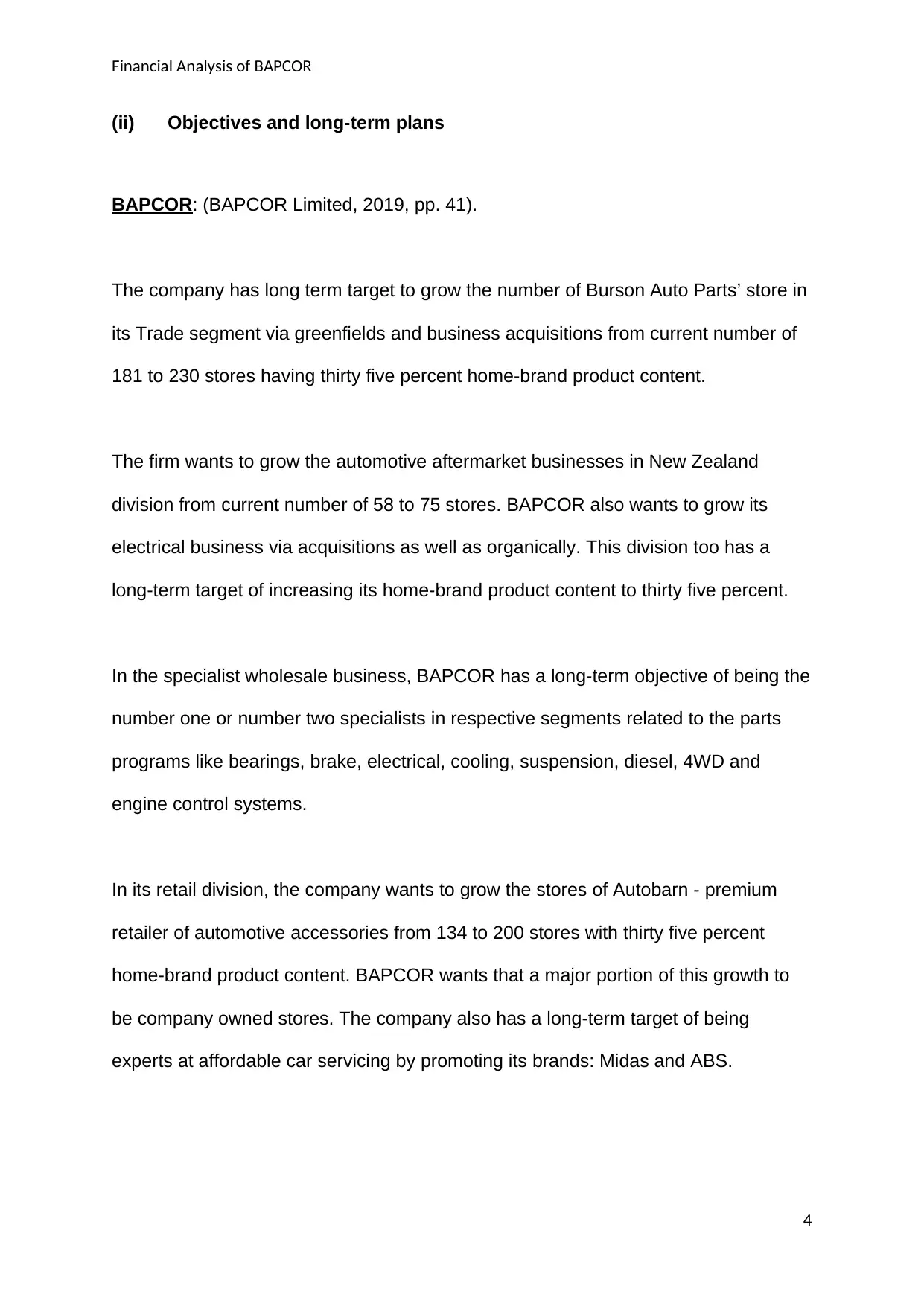
Financial Analysis of BAPCOR
(ii) Objectives and long-term plans
BAPCOR: (BAPCOR Limited, 2019, pp. 41).
The company has long term target to grow the number of Burson Auto Parts’ store in
its Trade segment via greenfields and business acquisitions from current number of
181 to 230 stores having thirty five percent home-brand product content.
The firm wants to grow the automotive aftermarket businesses in New Zealand
division from current number of 58 to 75 stores. BAPCOR also wants to grow its
electrical business via acquisitions as well as organically. This division too has a
long-term target of increasing its home-brand product content to thirty five percent.
In the specialist wholesale business, BAPCOR has a long-term objective of being the
number one or number two specialists in respective segments related to the parts
programs like bearings, brake, electrical, cooling, suspension, diesel, 4WD and
engine control systems.
In its retail division, the company wants to grow the stores of Autobarn - premium
retailer of automotive accessories from 134 to 200 stores with thirty five percent
home-brand product content. BAPCOR wants that a major portion of this growth to
be company owned stores. The company also has a long-term target of being
experts at affordable car servicing by promoting its brands: Midas and ABS.
4
(ii) Objectives and long-term plans
BAPCOR: (BAPCOR Limited, 2019, pp. 41).
The company has long term target to grow the number of Burson Auto Parts’ store in
its Trade segment via greenfields and business acquisitions from current number of
181 to 230 stores having thirty five percent home-brand product content.
The firm wants to grow the automotive aftermarket businesses in New Zealand
division from current number of 58 to 75 stores. BAPCOR also wants to grow its
electrical business via acquisitions as well as organically. This division too has a
long-term target of increasing its home-brand product content to thirty five percent.
In the specialist wholesale business, BAPCOR has a long-term objective of being the
number one or number two specialists in respective segments related to the parts
programs like bearings, brake, electrical, cooling, suspension, diesel, 4WD and
engine control systems.
In its retail division, the company wants to grow the stores of Autobarn - premium
retailer of automotive accessories from 134 to 200 stores with thirty five percent
home-brand product content. BAPCOR wants that a major portion of this growth to
be company owned stores. The company also has a long-term target of being
experts at affordable car servicing by promoting its brands: Midas and ABS.
4
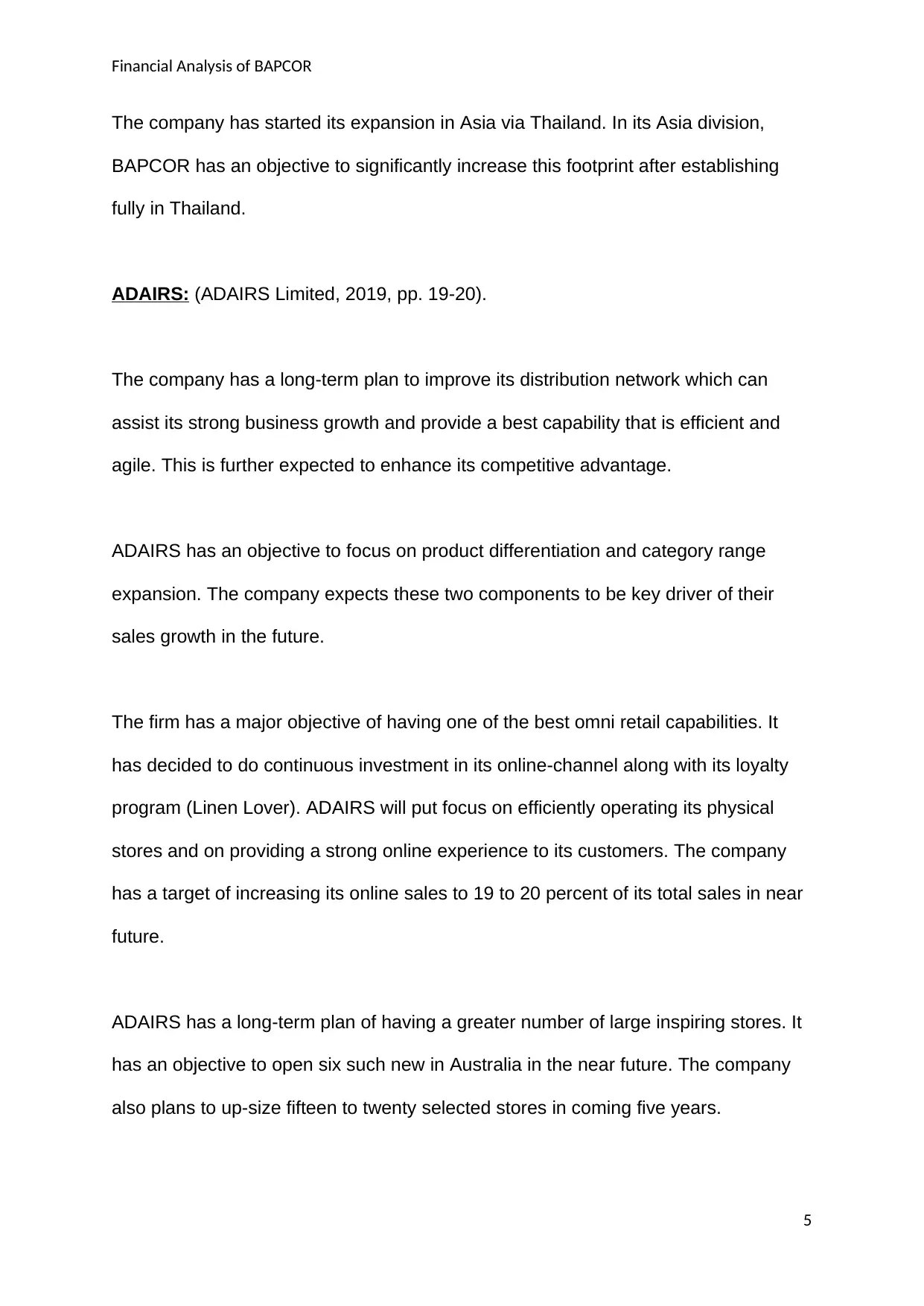
Financial Analysis of BAPCOR
The company has started its expansion in Asia via Thailand. In its Asia division,
BAPCOR has an objective to significantly increase this footprint after establishing
fully in Thailand.
ADAIRS: (ADAIRS Limited, 2019, pp. 19-20).
The company has a long-term plan to improve its distribution network which can
assist its strong business growth and provide a best capability that is efficient and
agile. This is further expected to enhance its competitive advantage.
ADAIRS has an objective to focus on product differentiation and category range
expansion. The company expects these two components to be key driver of their
sales growth in the future.
The firm has a major objective of having one of the best omni retail capabilities. It
has decided to do continuous investment in its online-channel along with its loyalty
program (Linen Lover). ADAIRS will put focus on efficiently operating its physical
stores and on providing a strong online experience to its customers. The company
has a target of increasing its online sales to 19 to 20 percent of its total sales in near
future.
ADAIRS has a long-term plan of having a greater number of large inspiring stores. It
has an objective to open six such new in Australia in the near future. The company
also plans to up-size fifteen to twenty selected stores in coming five years.
5
The company has started its expansion in Asia via Thailand. In its Asia division,
BAPCOR has an objective to significantly increase this footprint after establishing
fully in Thailand.
ADAIRS: (ADAIRS Limited, 2019, pp. 19-20).
The company has a long-term plan to improve its distribution network which can
assist its strong business growth and provide a best capability that is efficient and
agile. This is further expected to enhance its competitive advantage.
ADAIRS has an objective to focus on product differentiation and category range
expansion. The company expects these two components to be key driver of their
sales growth in the future.
The firm has a major objective of having one of the best omni retail capabilities. It
has decided to do continuous investment in its online-channel along with its loyalty
program (Linen Lover). ADAIRS will put focus on efficiently operating its physical
stores and on providing a strong online experience to its customers. The company
has a target of increasing its online sales to 19 to 20 percent of its total sales in near
future.
ADAIRS has a long-term plan of having a greater number of large inspiring stores. It
has an objective to open six such new in Australia in the near future. The company
also plans to up-size fifteen to twenty selected stores in coming five years.
5
⊘ This is a preview!⊘
Do you want full access?
Subscribe today to unlock all pages.

Trusted by 1+ million students worldwide
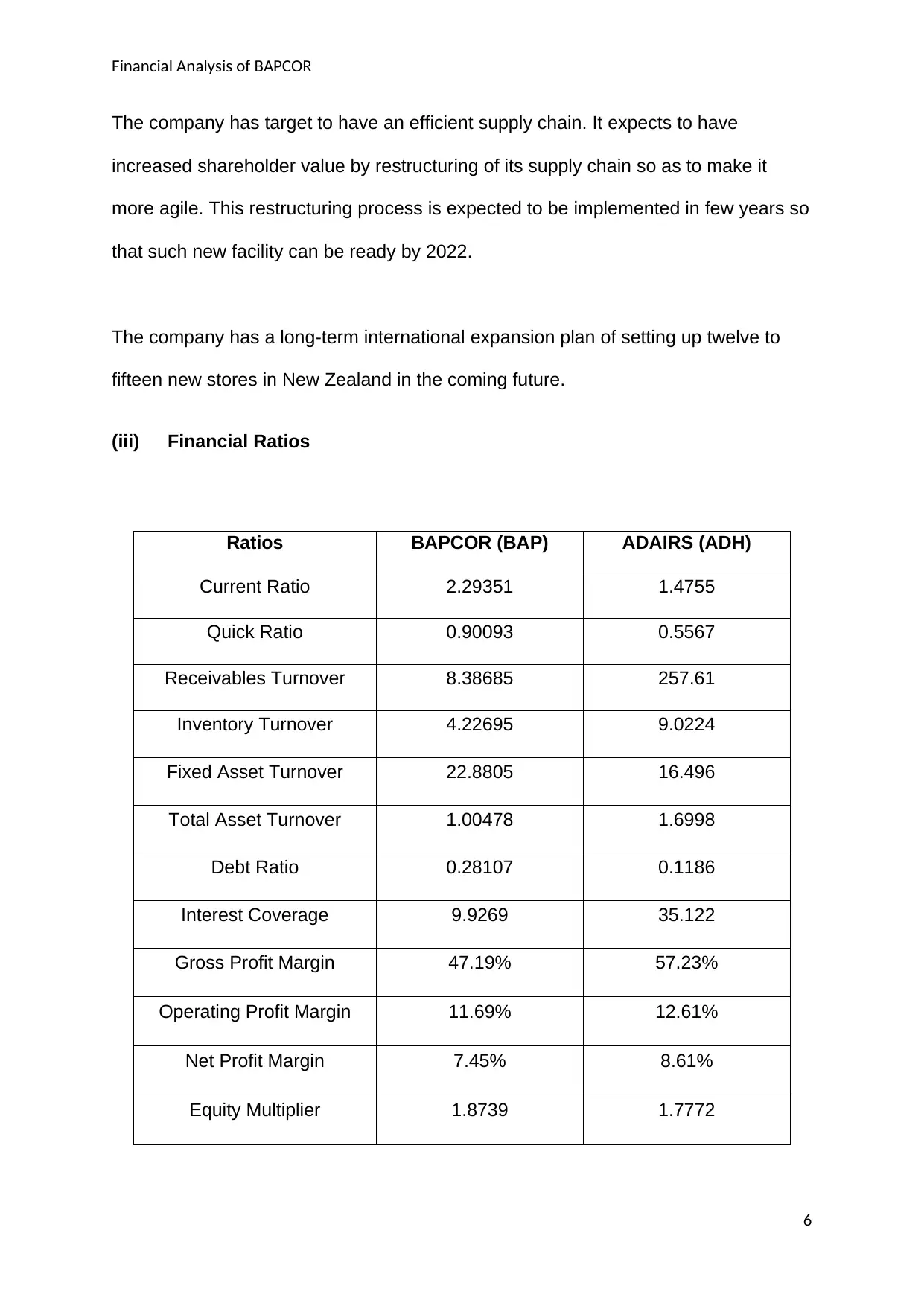
Financial Analysis of BAPCOR
The company has target to have an efficient supply chain. It expects to have
increased shareholder value by restructuring of its supply chain so as to make it
more agile. This restructuring process is expected to be implemented in few years so
that such new facility can be ready by 2022.
The company has a long-term international expansion plan of setting up twelve to
fifteen new stores in New Zealand in the coming future.
(iii) Financial Ratios
Ratios BAPCOR (BAP) ADAIRS (ADH)
Current Ratio 2.29351 1.4755
Quick Ratio 0.90093 0.5567
Receivables Turnover 8.38685 257.61
Inventory Turnover 4.22695 9.0224
Fixed Asset Turnover 22.8805 16.496
Total Asset Turnover 1.00478 1.6998
Debt Ratio 0.28107 0.1186
Interest Coverage 9.9269 35.122
Gross Profit Margin 47.19% 57.23%
Operating Profit Margin 11.69% 12.61%
Net Profit Margin 7.45% 8.61%
Equity Multiplier 1.8739 1.7772
6
The company has target to have an efficient supply chain. It expects to have
increased shareholder value by restructuring of its supply chain so as to make it
more agile. This restructuring process is expected to be implemented in few years so
that such new facility can be ready by 2022.
The company has a long-term international expansion plan of setting up twelve to
fifteen new stores in New Zealand in the coming future.
(iii) Financial Ratios
Ratios BAPCOR (BAP) ADAIRS (ADH)
Current Ratio 2.29351 1.4755
Quick Ratio 0.90093 0.5567
Receivables Turnover 8.38685 257.61
Inventory Turnover 4.22695 9.0224
Fixed Asset Turnover 22.8805 16.496
Total Asset Turnover 1.00478 1.6998
Debt Ratio 0.28107 0.1186
Interest Coverage 9.9269 35.122
Gross Profit Margin 47.19% 57.23%
Operating Profit Margin 11.69% 12.61%
Net Profit Margin 7.45% 8.61%
Equity Multiplier 1.8739 1.7772
6
Paraphrase This Document
Need a fresh take? Get an instant paraphrase of this document with our AI Paraphraser
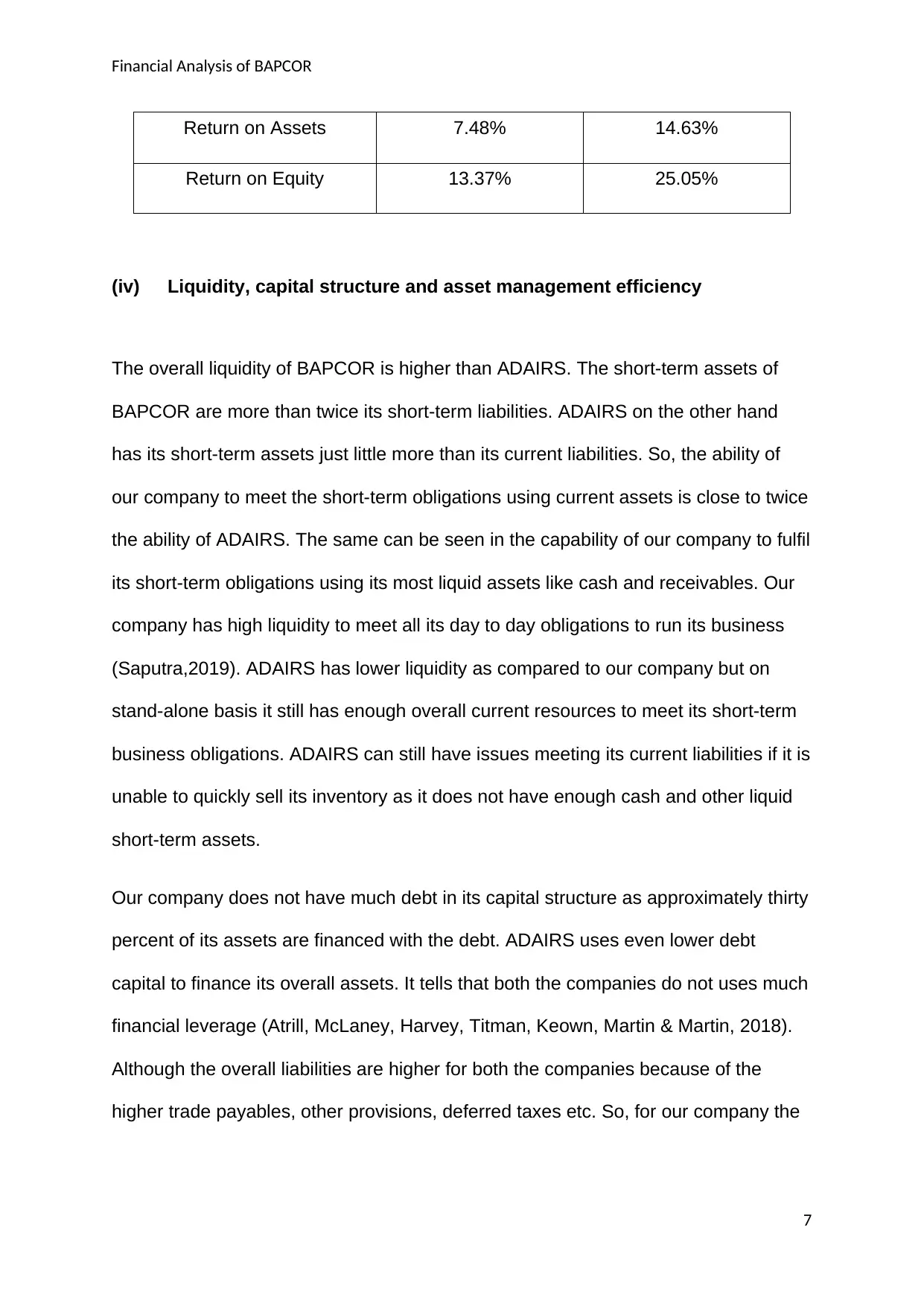
Financial Analysis of BAPCOR
Return on Assets 7.48% 14.63%
Return on Equity 13.37% 25.05%
(iv) Liquidity, capital structure and asset management efficiency
The overall liquidity of BAPCOR is higher than ADAIRS. The short-term assets of
BAPCOR are more than twice its short-term liabilities. ADAIRS on the other hand
has its short-term assets just little more than its current liabilities. So, the ability of
our company to meet the short-term obligations using current assets is close to twice
the ability of ADAIRS. The same can be seen in the capability of our company to fulfil
its short-term obligations using its most liquid assets like cash and receivables. Our
company has high liquidity to meet all its day to day obligations to run its business
(Saputra,2019). ADAIRS has lower liquidity as compared to our company but on
stand-alone basis it still has enough overall current resources to meet its short-term
business obligations. ADAIRS can still have issues meeting its current liabilities if it is
unable to quickly sell its inventory as it does not have enough cash and other liquid
short-term assets.
Our company does not have much debt in its capital structure as approximately thirty
percent of its assets are financed with the debt. ADAIRS uses even lower debt
capital to finance its overall assets. It tells that both the companies do not uses much
financial leverage (Atrill, McLaney, Harvey, Titman, Keown, Martin & Martin, 2018).
Although the overall liabilities are higher for both the companies because of the
higher trade payables, other provisions, deferred taxes etc. So, for our company the
7
Return on Assets 7.48% 14.63%
Return on Equity 13.37% 25.05%
(iv) Liquidity, capital structure and asset management efficiency
The overall liquidity of BAPCOR is higher than ADAIRS. The short-term assets of
BAPCOR are more than twice its short-term liabilities. ADAIRS on the other hand
has its short-term assets just little more than its current liabilities. So, the ability of
our company to meet the short-term obligations using current assets is close to twice
the ability of ADAIRS. The same can be seen in the capability of our company to fulfil
its short-term obligations using its most liquid assets like cash and receivables. Our
company has high liquidity to meet all its day to day obligations to run its business
(Saputra,2019). ADAIRS has lower liquidity as compared to our company but on
stand-alone basis it still has enough overall current resources to meet its short-term
business obligations. ADAIRS can still have issues meeting its current liabilities if it is
unable to quickly sell its inventory as it does not have enough cash and other liquid
short-term assets.
Our company does not have much debt in its capital structure as approximately thirty
percent of its assets are financed with the debt. ADAIRS uses even lower debt
capital to finance its overall assets. It tells that both the companies do not uses much
financial leverage (Atrill, McLaney, Harvey, Titman, Keown, Martin & Martin, 2018).
Although the overall liabilities are higher for both the companies because of the
higher trade payables, other provisions, deferred taxes etc. So, for our company the
7
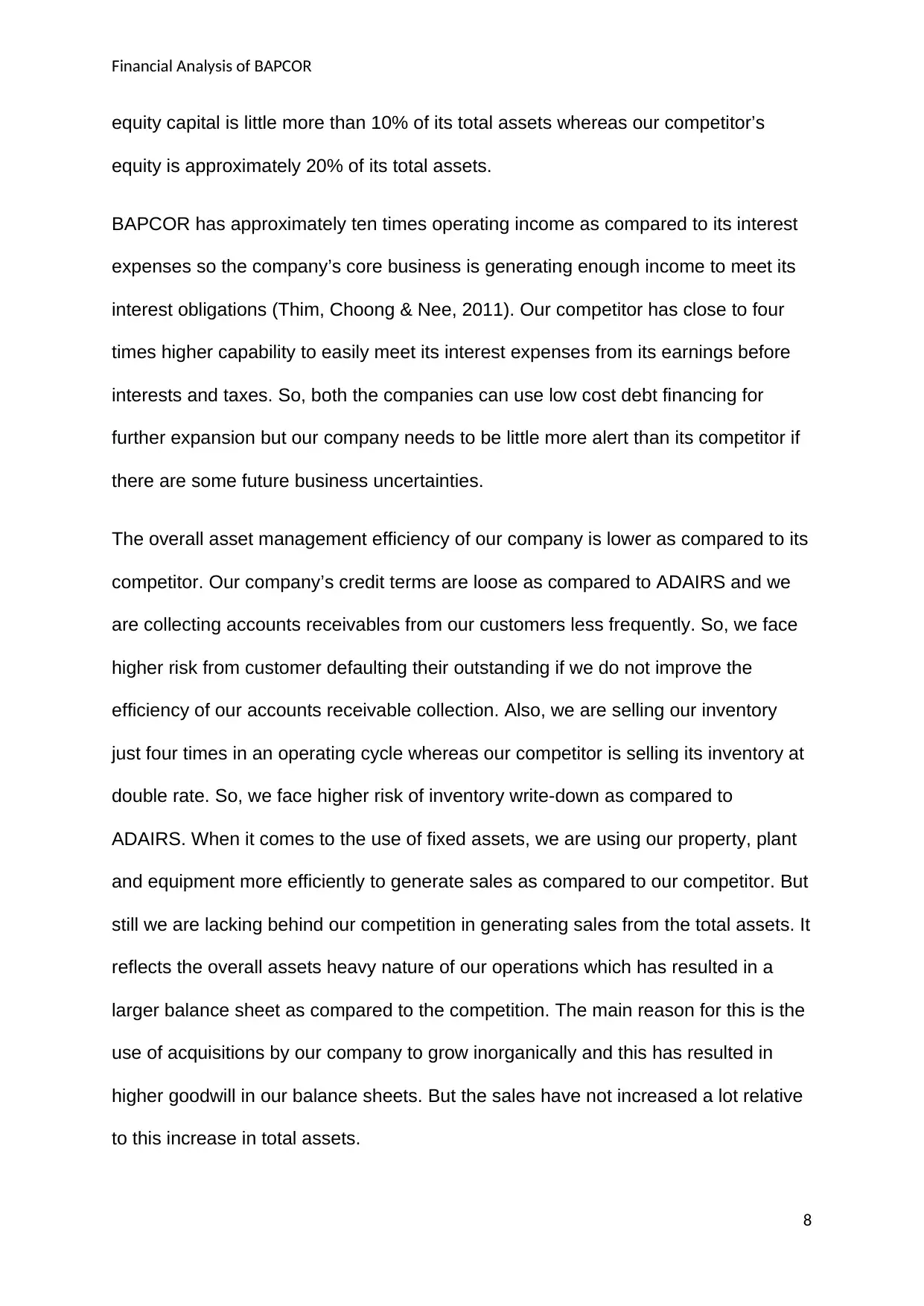
Financial Analysis of BAPCOR
equity capital is little more than 10% of its total assets whereas our competitor’s
equity is approximately 20% of its total assets.
BAPCOR has approximately ten times operating income as compared to its interest
expenses so the company’s core business is generating enough income to meet its
interest obligations (Thim, Choong & Nee, 2011). Our competitor has close to four
times higher capability to easily meet its interest expenses from its earnings before
interests and taxes. So, both the companies can use low cost debt financing for
further expansion but our company needs to be little more alert than its competitor if
there are some future business uncertainties.
The overall asset management efficiency of our company is lower as compared to its
competitor. Our company’s credit terms are loose as compared to ADAIRS and we
are collecting accounts receivables from our customers less frequently. So, we face
higher risk from customer defaulting their outstanding if we do not improve the
efficiency of our accounts receivable collection. Also, we are selling our inventory
just four times in an operating cycle whereas our competitor is selling its inventory at
double rate. So, we face higher risk of inventory write-down as compared to
ADAIRS. When it comes to the use of fixed assets, we are using our property, plant
and equipment more efficiently to generate sales as compared to our competitor. But
still we are lacking behind our competition in generating sales from the total assets. It
reflects the overall assets heavy nature of our operations which has resulted in a
larger balance sheet as compared to the competition. The main reason for this is the
use of acquisitions by our company to grow inorganically and this has resulted in
higher goodwill in our balance sheets. But the sales have not increased a lot relative
to this increase in total assets.
8
equity capital is little more than 10% of its total assets whereas our competitor’s
equity is approximately 20% of its total assets.
BAPCOR has approximately ten times operating income as compared to its interest
expenses so the company’s core business is generating enough income to meet its
interest obligations (Thim, Choong & Nee, 2011). Our competitor has close to four
times higher capability to easily meet its interest expenses from its earnings before
interests and taxes. So, both the companies can use low cost debt financing for
further expansion but our company needs to be little more alert than its competitor if
there are some future business uncertainties.
The overall asset management efficiency of our company is lower as compared to its
competitor. Our company’s credit terms are loose as compared to ADAIRS and we
are collecting accounts receivables from our customers less frequently. So, we face
higher risk from customer defaulting their outstanding if we do not improve the
efficiency of our accounts receivable collection. Also, we are selling our inventory
just four times in an operating cycle whereas our competitor is selling its inventory at
double rate. So, we face higher risk of inventory write-down as compared to
ADAIRS. When it comes to the use of fixed assets, we are using our property, plant
and equipment more efficiently to generate sales as compared to our competitor. But
still we are lacking behind our competition in generating sales from the total assets. It
reflects the overall assets heavy nature of our operations which has resulted in a
larger balance sheet as compared to the competition. The main reason for this is the
use of acquisitions by our company to grow inorganically and this has resulted in
higher goodwill in our balance sheets. But the sales have not increased a lot relative
to this increase in total assets.
8
⊘ This is a preview!⊘
Do you want full access?
Subscribe today to unlock all pages.

Trusted by 1+ million students worldwide
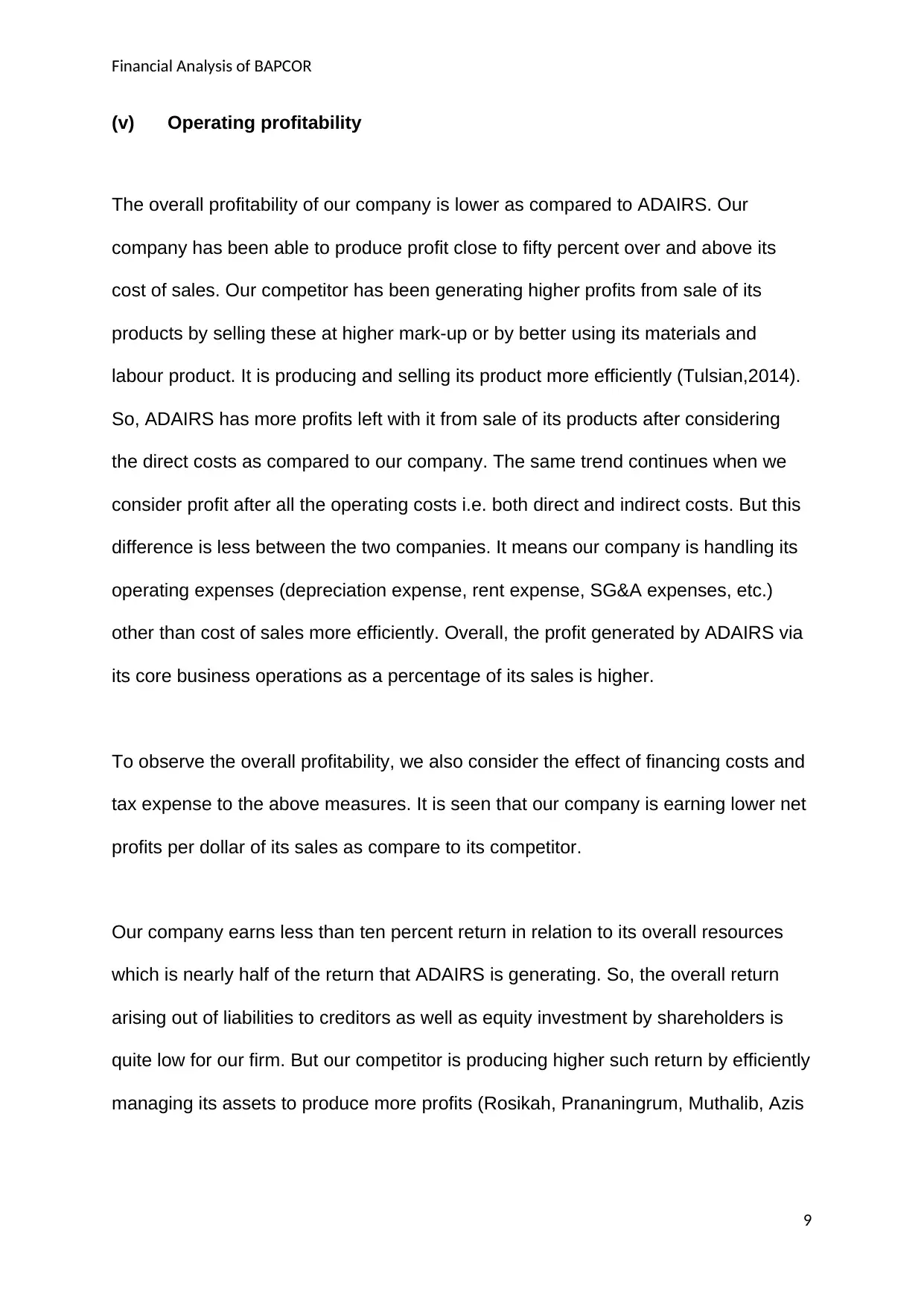
Financial Analysis of BAPCOR
(v) Operating profitability
The overall profitability of our company is lower as compared to ADAIRS. Our
company has been able to produce profit close to fifty percent over and above its
cost of sales. Our competitor has been generating higher profits from sale of its
products by selling these at higher mark-up or by better using its materials and
labour product. It is producing and selling its product more efficiently (Tulsian,2014).
So, ADAIRS has more profits left with it from sale of its products after considering
the direct costs as compared to our company. The same trend continues when we
consider profit after all the operating costs i.e. both direct and indirect costs. But this
difference is less between the two companies. It means our company is handling its
operating expenses (depreciation expense, rent expense, SG&A expenses, etc.)
other than cost of sales more efficiently. Overall, the profit generated by ADAIRS via
its core business operations as a percentage of its sales is higher.
To observe the overall profitability, we also consider the effect of financing costs and
tax expense to the above measures. It is seen that our company is earning lower net
profits per dollar of its sales as compare to its competitor.
Our company earns less than ten percent return in relation to its overall resources
which is nearly half of the return that ADAIRS is generating. So, the overall return
arising out of liabilities to creditors as well as equity investment by shareholders is
quite low for our firm. But our competitor is producing higher such return by efficiently
managing its assets to produce more profits (Rosikah, Prananingrum, Muthalib, Azis
9
(v) Operating profitability
The overall profitability of our company is lower as compared to ADAIRS. Our
company has been able to produce profit close to fifty percent over and above its
cost of sales. Our competitor has been generating higher profits from sale of its
products by selling these at higher mark-up or by better using its materials and
labour product. It is producing and selling its product more efficiently (Tulsian,2014).
So, ADAIRS has more profits left with it from sale of its products after considering
the direct costs as compared to our company. The same trend continues when we
consider profit after all the operating costs i.e. both direct and indirect costs. But this
difference is less between the two companies. It means our company is handling its
operating expenses (depreciation expense, rent expense, SG&A expenses, etc.)
other than cost of sales more efficiently. Overall, the profit generated by ADAIRS via
its core business operations as a percentage of its sales is higher.
To observe the overall profitability, we also consider the effect of financing costs and
tax expense to the above measures. It is seen that our company is earning lower net
profits per dollar of its sales as compare to its competitor.
Our company earns less than ten percent return in relation to its overall resources
which is nearly half of the return that ADAIRS is generating. So, the overall return
arising out of liabilities to creditors as well as equity investment by shareholders is
quite low for our firm. But our competitor is producing higher such return by efficiently
managing its assets to produce more profits (Rosikah, Prananingrum, Muthalib, Azis
9
Paraphrase This Document
Need a fresh take? Get an instant paraphrase of this document with our AI Paraphraser
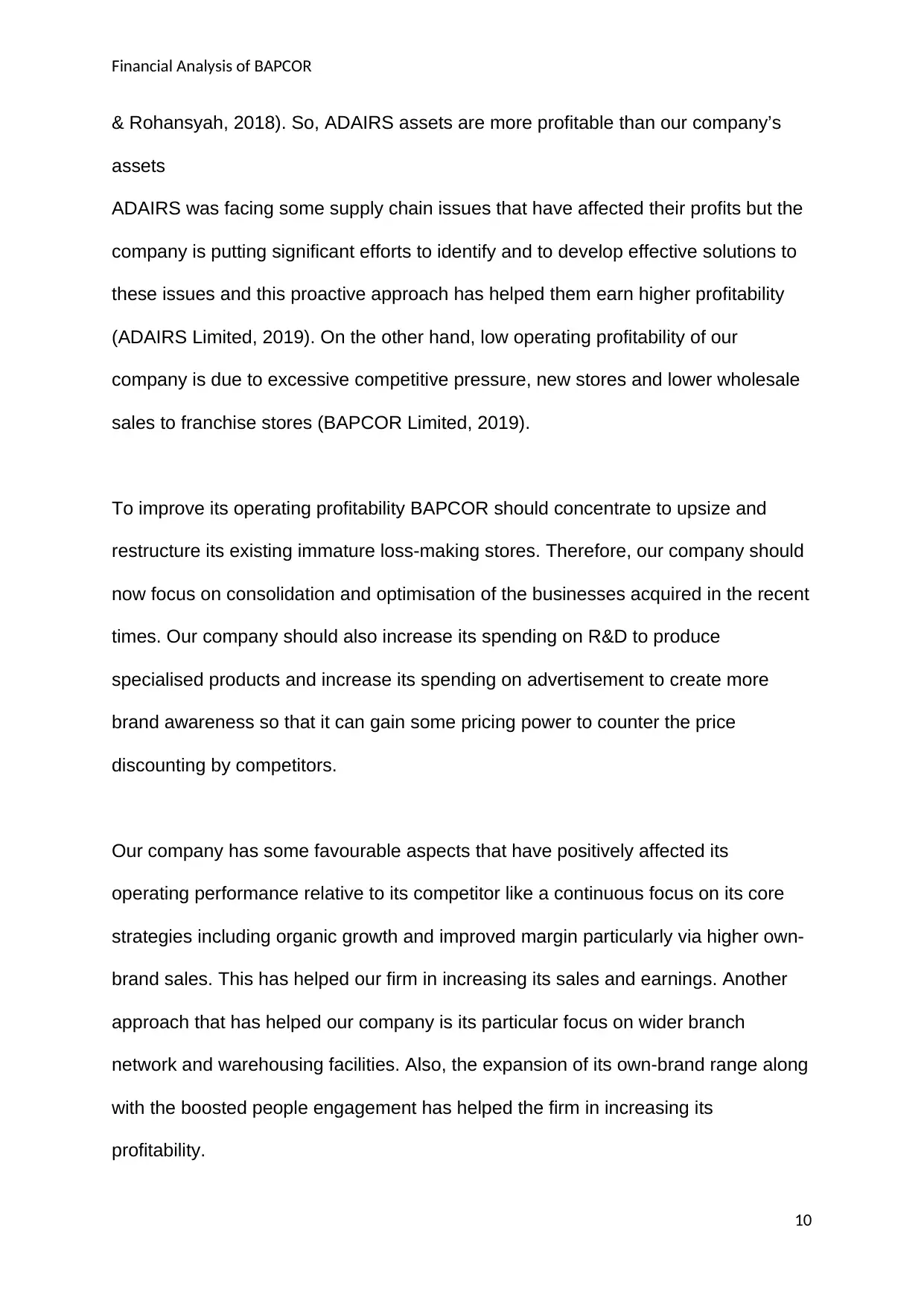
Financial Analysis of BAPCOR
& Rohansyah, 2018). So, ADAIRS assets are more profitable than our company’s
assets
ADAIRS was facing some supply chain issues that have affected their profits but the
company is putting significant efforts to identify and to develop effective solutions to
these issues and this proactive approach has helped them earn higher profitability
(ADAIRS Limited, 2019). On the other hand, low operating profitability of our
company is due to excessive competitive pressure, new stores and lower wholesale
sales to franchise stores (BAPCOR Limited, 2019).
To improve its operating profitability BAPCOR should concentrate to upsize and
restructure its existing immature loss-making stores. Therefore, our company should
now focus on consolidation and optimisation of the businesses acquired in the recent
times. Our company should also increase its spending on R&D to produce
specialised products and increase its spending on advertisement to create more
brand awareness so that it can gain some pricing power to counter the price
discounting by competitors.
Our company has some favourable aspects that have positively affected its
operating performance relative to its competitor like a continuous focus on its core
strategies including organic growth and improved margin particularly via higher own-
brand sales. This has helped our firm in increasing its sales and earnings. Another
approach that has helped our company is its particular focus on wider branch
network and warehousing facilities. Also, the expansion of its own-brand range along
with the boosted people engagement has helped the firm in increasing its
profitability.
10
& Rohansyah, 2018). So, ADAIRS assets are more profitable than our company’s
assets
ADAIRS was facing some supply chain issues that have affected their profits but the
company is putting significant efforts to identify and to develop effective solutions to
these issues and this proactive approach has helped them earn higher profitability
(ADAIRS Limited, 2019). On the other hand, low operating profitability of our
company is due to excessive competitive pressure, new stores and lower wholesale
sales to franchise stores (BAPCOR Limited, 2019).
To improve its operating profitability BAPCOR should concentrate to upsize and
restructure its existing immature loss-making stores. Therefore, our company should
now focus on consolidation and optimisation of the businesses acquired in the recent
times. Our company should also increase its spending on R&D to produce
specialised products and increase its spending on advertisement to create more
brand awareness so that it can gain some pricing power to counter the price
discounting by competitors.
Our company has some favourable aspects that have positively affected its
operating performance relative to its competitor like a continuous focus on its core
strategies including organic growth and improved margin particularly via higher own-
brand sales. This has helped our firm in increasing its sales and earnings. Another
approach that has helped our company is its particular focus on wider branch
network and warehousing facilities. Also, the expansion of its own-brand range along
with the boosted people engagement has helped the firm in increasing its
profitability.
10
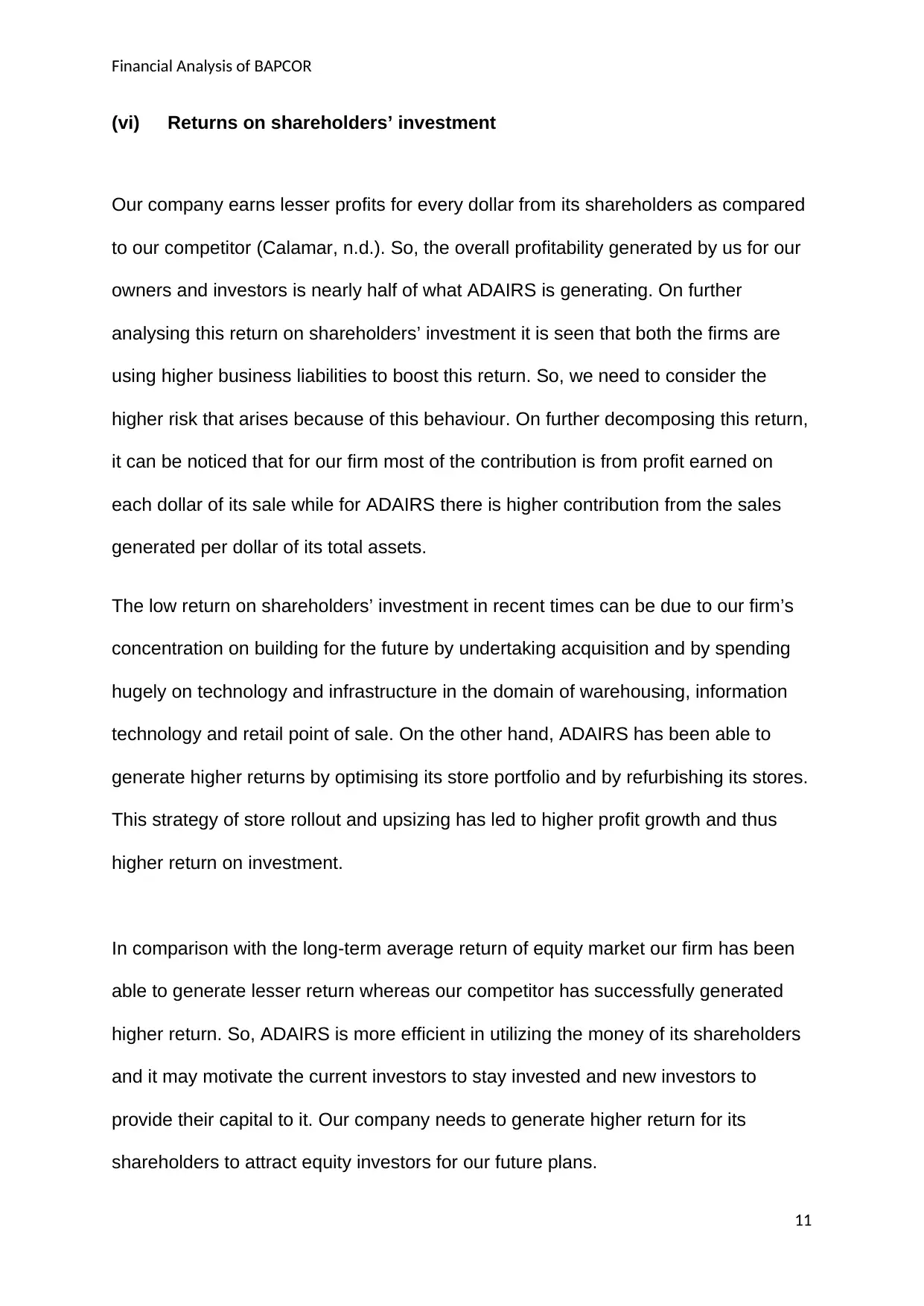
Financial Analysis of BAPCOR
(vi) Returns on shareholders’ investment
Our company earns lesser profits for every dollar from its shareholders as compared
to our competitor (Calamar, n.d.). So, the overall profitability generated by us for our
owners and investors is nearly half of what ADAIRS is generating. On further
analysing this return on shareholders’ investment it is seen that both the firms are
using higher business liabilities to boost this return. So, we need to consider the
higher risk that arises because of this behaviour. On further decomposing this return,
it can be noticed that for our firm most of the contribution is from profit earned on
each dollar of its sale while for ADAIRS there is higher contribution from the sales
generated per dollar of its total assets.
The low return on shareholders’ investment in recent times can be due to our firm’s
concentration on building for the future by undertaking acquisition and by spending
hugely on technology and infrastructure in the domain of warehousing, information
technology and retail point of sale. On the other hand, ADAIRS has been able to
generate higher returns by optimising its store portfolio and by refurbishing its stores.
This strategy of store rollout and upsizing has led to higher profit growth and thus
higher return on investment.
In comparison with the long-term average return of equity market our firm has been
able to generate lesser return whereas our competitor has successfully generated
higher return. So, ADAIRS is more efficient in utilizing the money of its shareholders
and it may motivate the current investors to stay invested and new investors to
provide their capital to it. Our company needs to generate higher return for its
shareholders to attract equity investors for our future plans.
11
(vi) Returns on shareholders’ investment
Our company earns lesser profits for every dollar from its shareholders as compared
to our competitor (Calamar, n.d.). So, the overall profitability generated by us for our
owners and investors is nearly half of what ADAIRS is generating. On further
analysing this return on shareholders’ investment it is seen that both the firms are
using higher business liabilities to boost this return. So, we need to consider the
higher risk that arises because of this behaviour. On further decomposing this return,
it can be noticed that for our firm most of the contribution is from profit earned on
each dollar of its sale while for ADAIRS there is higher contribution from the sales
generated per dollar of its total assets.
The low return on shareholders’ investment in recent times can be due to our firm’s
concentration on building for the future by undertaking acquisition and by spending
hugely on technology and infrastructure in the domain of warehousing, information
technology and retail point of sale. On the other hand, ADAIRS has been able to
generate higher returns by optimising its store portfolio and by refurbishing its stores.
This strategy of store rollout and upsizing has led to higher profit growth and thus
higher return on investment.
In comparison with the long-term average return of equity market our firm has been
able to generate lesser return whereas our competitor has successfully generated
higher return. So, ADAIRS is more efficient in utilizing the money of its shareholders
and it may motivate the current investors to stay invested and new investors to
provide their capital to it. Our company needs to generate higher return for its
shareholders to attract equity investors for our future plans.
11
⊘ This is a preview!⊘
Do you want full access?
Subscribe today to unlock all pages.

Trusted by 1+ million students worldwide
1 out of 16
Related Documents
Your All-in-One AI-Powered Toolkit for Academic Success.
+13062052269
info@desklib.com
Available 24*7 on WhatsApp / Email
![[object Object]](/_next/static/media/star-bottom.7253800d.svg)
Unlock your academic potential
Copyright © 2020–2025 A2Z Services. All Rights Reserved. Developed and managed by ZUCOL.





